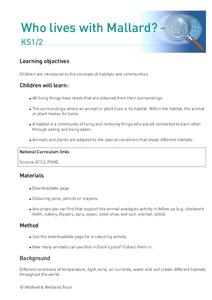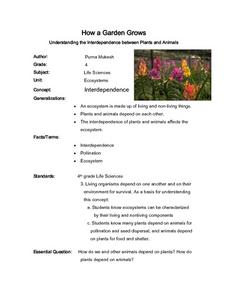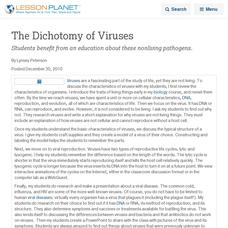Curated OER
Who lives with Mallard?
Young scholars explore how all living things have needs that are obtained from their surroundings. They identify the surroundings where an animal or plant lives is its habitat. Students identify that a habitat is a community of living...
Curated OER
Color in the Garden
Third graders study color in a garden environment. In this color lesson, 3rd graders explore the colors of living and nonliving elements within a garden environment. Resources are provided.
Curated OER
Summer Scientists
In this lesson, pupils discuss and reocrd what makes an object living or nonliving. The students then chart the lists of living and nonliving objects. Teacher allows pupils oportunity to go outside and look for living and ninliving...
Curated OER
How A Garden Grows
Fourth graders explore the importance of plants to animals and visa versa. After reading a book, The Tree in the Ancient Forest, they explore how plants and animals are independent. Students list living and nonliving things they...
Curated OER
Observing and Recording Biological Data
Students create their own definition of life. They identify the eight characteristics of life in organisms. They compare and contrast the characteristics of living and nonliving things.
Curated OER
Looking at the Community Tree
Third graders review the characteristics of living and nonliving organisms. As a class, they observe a tree and describe the interactions between the living and nonliving organisms surrounding it. To end the lesson, they ask a question...
Chicago Botanic Garden
Carbon, Greenhouse Gases, and Climate
Climate models mathematically represent the interactions of the atmosphere, oceans, land, sun, surface, and ice. Part two in the series of four lessons looks at the role greenhouse gases play in keeping Earth warm and has participants...
Curated OER
Scavenging the Sandy Shore
Students explore oceanography by examining a beach. In this living things lesson plan, students define the terms abiotic and biotic and practice identifying living and non-living things that have been previously found on a beach....
National Park Service
Living & Non-Living Interactions
What better way to learn about ecosystems than by getting outside and observing them first hand? Accompanying a field trip to a local park or outdoor space, this series of collaborative activities engages children in learning about the...
Curated OER
Living vs. Non-living
Students go on a nature walk and observe and discuss the living and non living things they see in the ecosystem. For this living and non living lesson plan, students complete a connecting string activity to simulate an ecosystem.
Curated OER
The Many, Varied, and Unusual Places and Things on Earth
Students discover how energy flows through communities because of the relationship between producers, consumers and decomposers. Examining various ecosystems, they identify the materials that cycle continuously through them. They label...
Curated OER
Cell Structures and Functions
Fifth graders search into animal and cell characteristics and their functions in this seven lesson unit. Replicas of the cell are constructed out of Jell-O as students probe the internet for details of the concepts.
Curated OER
"Garden Springs Gardeners"
First graders ponder the question of how plants help their lives. They observe and compare properties of several different plants. Differentiate between living organisms and nonliving objects.
Pennsylvania Department of Education
Animal Classes and Their Ecosystems
Students explore animal characteristics by participating in an environment identification activity. In this animal habitat lesson, students discuss a range of different wild life and the ecosystems that they are a part of. Students view...
Curated OER
Living, Non-Living Mobile
Students are introduced to the concept of living and nonliving organisms in general and participate in a starter activity where they build their own definitions of living and nonliving organisms.They sort organisms into living and...
Curated OER
What Makes Up Rocks and Soils?
In this rocks and soils worksheet, students will complete a Venn diagram comparing the specific characteristics of rocks and soils.
Curated OER
What It Is, What It Isn't
Third graders classify and sort different types of beans to be introduced to the classification system in science. As a class, they identify the characteristics of living and non-living organisms and make a chart in their journal to ...
Curated OER
Lunch
First graders view and sort a display of fruits and vegetables by one characteristic. They listen as the teacher reads the story, "Lunch." Students identify items on the pages as living or nonliving, fruit or vegetable. Using magazines,...
Curated OER
A Couch or a Potato
Students classify objects and organisms seen on the Wakulla Springs icam website as living or nonliving.
Curated OER
Exploring the Great Salt Lake
Third graders participate in a scavenger hunt, looking for things that are unique about the ecosystem in and around the lake. They observe and describe a variety of habitats and distinguish living and nonliving elements of...
Curated OER
Extra! Extra!
Learners describe how plants and animals depend on each other. They see how living and nonliving environments change over time. They identify ways in which humans have changed their environment and the effects of those changes.
Curated OER
Parts of an Ecosystem
Fourth graders study the Great Salt lake and the ecosystem that encompasses it. They study the relationship between an individual of a species, a population of that species, a community that includes that population, and the...
Curated OER
The Dichotomy of Viruses
Students benefit from an education about these nonliving pathogens.
Curated OER
Soil Composition
Students examine soil. In this soil composition lesson students participate in soil sedimentation and filtration activities. The students discuss what non-living and living things are in soil and why it is so important.
Other popular searches
- Living and Nonliving Things
- Living vs Nonliving Things
- Living or Nonliving Things
- Living Nonliving Things
- Living/nonliving Things

























